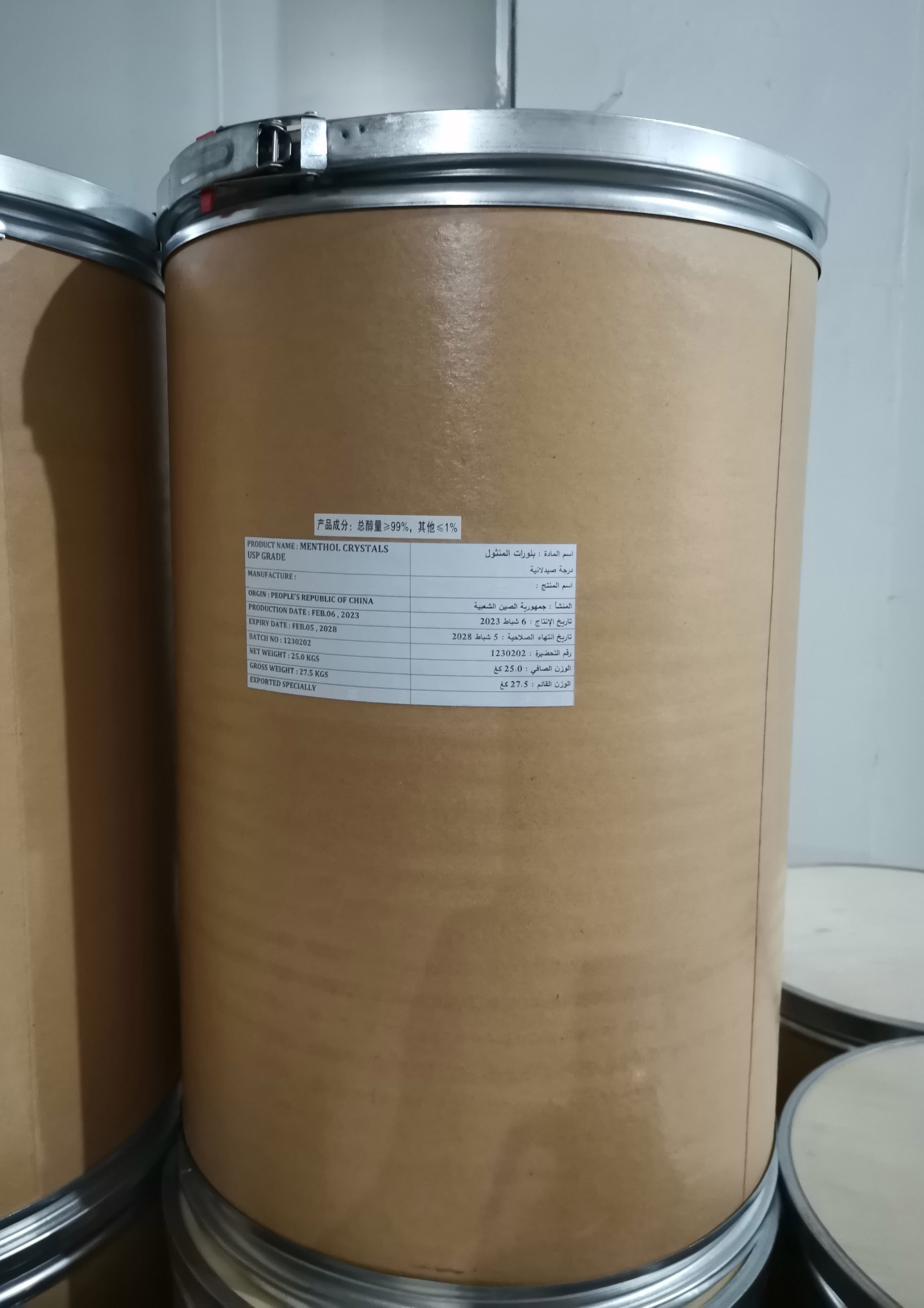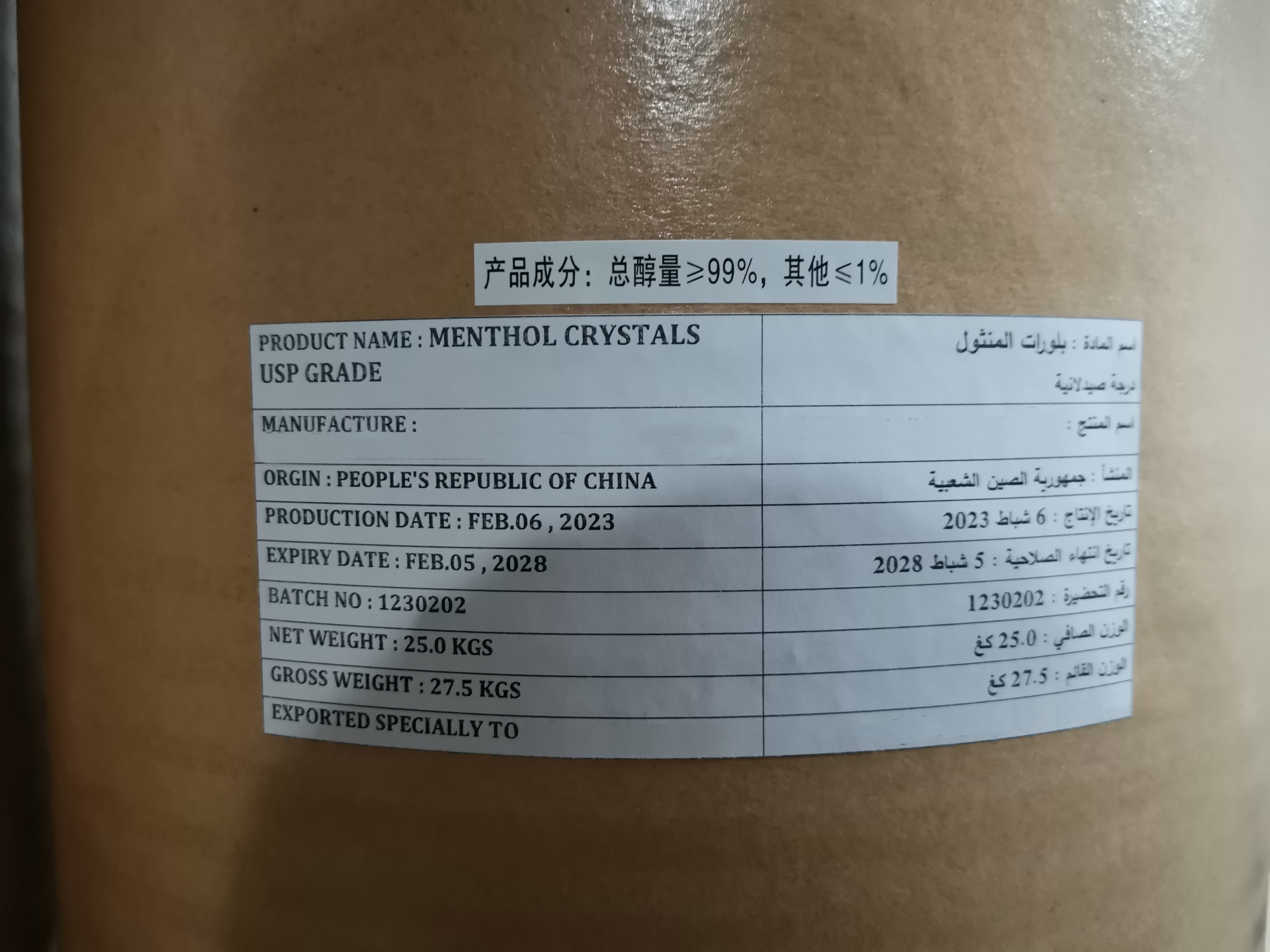📌 Detailed Introduction of Menthol
✔ What is Menthol?
Menthol is an organic compound derived from peppermint or produced synthetically. It is well known for its cooling sensation, refreshing minty aroma, and medicinal properties. Menthol is widely used as a flavoring, analgesic, decongestant, and cooling agent in various industries.
✔ CAS Number & Chemical Formula:
CAS Number: 2216-51-5
Chemical Formula: C₁₀H₂₀O
Molecular Weight: 156.27 g/mol
📌 Product Specifications
| Property | Specification |
|---|---|
| Appearance | Colorless or white crystalline solid |
| Purity (%) | ≥ 99% (Food/Pharmaceutical Grade) |
| Odor | Characteristic strong mint aroma |
| Melting Point (°C) | 41 – 44°C |
| Specific Rotation | -49° to -50° |
| Solubility | Soluble in alcohol, ether, chloroform; slightly soluble in water |
| Packing | 25kg fiber drums or as per customer requirements |
📌 Applications of Menthol
✔ Food & Beverage Industry
Used as a flavoring agent in chewing gum, candies, and beverages.
Provides a cooling and refreshing taste in confectionery and oral care products.
✔ Pharmaceutical Industry
Used in topical analgesics and pain relief balms for its cooling and soothing effect.
Acts as a decongestant in cough drops, lozenges, and nasal sprays.
Used in oral hygiene products like toothpaste and mouthwash for freshness.
✔ Cosmetic & Personal Care
Key ingredient in shampoos, body lotions, and cooling gels.
Used in aftershave and skincare products for a refreshing feel.
✔ Tobacco Industry
Used as a flavor additive in menthol cigarettes to provide a cooling effect.
✔ Aromatherapy & Fragrance
Popular in essential oils and aromatherapy for its relaxing and decongesting properties.
📌 How Does Menthol Work?
Cooling Effect:
Activates cold-sensitive TRPM8 receptors in the skin and mucous membranes, creating a cooling sensation without lowering temperature.
Flavor & Aroma Enhancement:
Adds a minty and refreshing flavor in food, beverages, and oral care products.
Pain Relief & Decongestion:
Provides a soothing effect by interacting with nerve receptors, helping relieve minor aches, congestion, and sore throat symptoms.
📌 Production Method & Raw Materials
✔ Natural Menthol Extraction:
Steam distillation of peppermint oil to extract menthol.
Crystallization process to purify menthol from essential oils.
✔ Synthetic Menthol Production:
Produced from m-cresol via hydrogenation and isomerization processes.
📌 Famous Menthol Brands Worldwide
BASF (Germany)
Takasago (Japan)
Symrise (Germany)
Jiangsu Khonor Chemicals Co., Limited (China)
📌 Why Choose Jiangsu Khonor Chemicals Co., Limited?
✔ High-Purity Natural & Synthetic Menthol
✔ ISO & GMP-Certified Manufacturing
✔ Competitive Pricing & Bulk Supply
✔ Custom Packaging & Global Distribution
📌 Order High-Quality Menthol from Jiangsu Khonor Chemicals Co., Limited!
Looking for a trusted Menthol supplier? Jiangsu Khonor Chemicals Co., Limited provides bulk supply of premium-grade Menthol for food, pharmaceutical, and cosmetic applications.
📞 Contact us today for a free quote & sample!
Menthol
Name of Index | USP |
Melting point | 42-44 |
NON-VOLATILE MATTER | ≤0.05% |
SPECIFIC ROTATION | -48℃-51℃ |
Purity | ≥99.0 |
Menthol is a naturally occurring compound that is known for its minty, cooling sensation. It is classified as a cyclic monoterpene alcohol and is commonly found in mint oils, especially in Mentha arvensis (wild mint) and Mentha piperita (peppermint). It is widely used in a variety of products, including food, cosmetics, pharmaceuticals, and personal care items, due to its distinctive aroma, flavor, and soothing properties.
Chemical Structure and Properties
Menthol has the chemical formula C₁₀H₂₀O and its structure consists of a six-membered cyclohexane ring with a hydroxyl group (-OH) and a methyl group (-CH₃) attached at specific positions. This structure is responsible for its characteristic cooling effect.
Key Properties:
Physical state: White crystalline solid at room temperature.
Melting point: 42–44°C (108–111°F).
Boiling point: 212°C (413.6°F).
Solubility: Sparingly soluble in water but soluble in alcohol, chloroform, and oils.
Odor and taste: Menthol has a strong, minty odor and a sharp, cool taste that can stimulate cold receptors in the skin and mucous membranes.
Natural Sources
Menthol is primarily extracted from mint plants, notably peppermint (Mentha piperita) and Japanese mint (Mentha arvensis). In addition to being present in essential oils, menthol can be synthesized from certain natural precursors, though most commercial menthol is now produced synthetically from petrochemical products to meet global demand.
Uses of Menthol
Food and Beverages:
Menthol is commonly used as a flavoring agent in foods like chewing gum, candies, ice cream, and beverages (particularly mint teas and some alcoholic drinks). It adds a cool, refreshing taste and aroma.
Cosmetics and Personal Care:
Menthol is a popular ingredient in a wide range of personal care products, including lotions, shampoos, deodorants, and facial products. It is valued for its cooling effect and is often used to relieve itching, skin irritation, and provide a sensation of freshness.
Pharmaceuticals:
Menthol is used in topical medications like ointments, balms, and creams for its analgesic (pain-relieving) and cooling properties. It is a common ingredient in cough drops, throat lozenges, and chest rubs (e.g., Vicks VapoRub), where it helps soothe sore throats and alleviate cough symptoms by promoting the feeling of airways opening.
Menthol is also found in products aimed at relieving muscle and joint pain, as it helps reduce inflammation and provides temporary relief from discomfort.
Tobacco Products:
Menthol has been historically added to cigarettes and smokeless tobacco products to enhance flavor, mask the harshness of tobacco, and provide a cooling effect when inhaled. The use of menthol in cigarettes has been a subject of regulatory concern, especially regarding its role in increasing smoking initiation and addiction, particularly among younger smokers.
Aromatherapy:
Menthol is used in essential oil form for its refreshing and stimulating properties in aromatherapy. It is believed to help clear sinuses, relieve headaches, and reduce mental fatigue.
Mechanism of Action (Cooling Sensation)
Menthol produces its characteristic cooling effect through its interaction with the TRPM8 receptor, a temperature-sensitive receptor found in sensory neurons. When menthol binds to this receptor, it triggers a response in the body that mimics the sensation of coolness, even though the temperature itself has not changed. This cooling sensation is why menthol is so effective in topical ointments for pain relief, as it can soothe irritated skin and muscle tissues.
Health and Safety Considerations
While menthol is generally considered safe when used in moderate amounts, excessive consumption or topical application can lead to adverse effects, including:
Skin Irritation: Prolonged contact with high concentrations of menthol may cause redness, burning, or irritation.
Respiratory Effects: Inhalation of menthol vapors in high concentrations may cause respiratory irritation or discomfort in some individuals.
Toxicity: In rare cases, ingesting large quantities of menthol can lead to symptoms such as nausea, vomiting, abdominal pain, and even more severe toxic reactions.
Synthesis of Menthol
In addition to being sourced from natural plants, menthol can be synthesized in laboratories. The process often starts with pulegone, a compound derived from peppermint oil, which is then hydrogenated to produce menthol. Synthetic menthol is indistinguishable from natural menthol and is typically less expensive to produce at large scales.
Conclusion
Menthol is a versatile and widely used compound with applications across multiple industries, from food and cosmetics to pharmaceuticals and tobacco. Its distinctive cooling effect, refreshing flavor, and soothing properties make it an indispensable ingredient in a wide range of products. However, like any compound, its use should be regulated to avoid potential adverse effects in sensitive individuals.



